Analysis of the Life Cycle Cost of a Heat Recovery System from Greywater Using a Vertical “Tube-in-Tube” Heat Exchanger: Case Study of Poland
Abstract
:1. Introduction
2. Materials and Methods
2.1. Research Model
2.2. Heat Recovery Efficiency Analysis
2.3. Economic Analysis
2.3.1. Case of Study
2.3.2. Life Cycle Cost Analysis
2.4. Sensitivity Analysis
- Scenario I—an increase in electricity prices by 21.50% according to the Institute of Renewable Energy;
- Scenario II—an increase in electricity prices by 27.20% according to PEP2040;
- Scenario III—an increase in electricity prices by 42.40% according to the NABE BASE [57].
3. Results and Discussion
3.1. Heat Recovery Efficiency Analysis
3.2. Life Cycle Cost Analysis
- EUR 3104 for Variant I, EUR 2395 for Variant II, and EUR 2151 for Variant III when the temperature of the mixed water (Tm) is 42 °C and the volume flow rate of water at the showerhead (Q) is 7.5 dm3/min.
- EUR 4428 for Variant I, EUR 3541 for Variant II, and EUR 3144 for Variant III when the temperature of the mixed water (Tm) is 42 °C and the volume flow rate of water at the showerhead (Q) is 10 dm3/min.
- EUR 2523 for Variant I, EUR 1628 for Variant II, and EUR 1885 for Variant III when the temperature of the mixed water (Tm) is 38 °C and the volume flow rate of water at the showerhead (Q) is 7.5 dm3/min.
- EUR 3628 for Variant I, EUR 2511 for Variant II, and EUR 2831 for Variant III when the temperature of the mixed water (Tm) is 38 °C and the volume flow rate of water at the showerhead (Q) is 10 dm3/min.
3.3. Sensitivity Analysis
4. Conclusions
- The configuration of the heat recovery system significantly impacts the level of financial savings achieved and the payback period.
- As demonstrated by the scenario analysis, projected increases in electricity prices can have a significant impact on the economic efficiency of the investment, leading to a shorter period for the investor to reap the financial benefits resulting from reduced energy consumption for the preparation of domestic hot water.
- The Life Cycle Cost (LCC) indicators of individual configurations of domestic hot water preparation system are not equally susceptible to changes in electricity prices.
- It can be inferred that the payback period for the initial investment will further decrease with the adoption of a scenario assuming a more negative forecast of electricity price increases.
- Energy and economic analysis of collective wastewater heat recovery systems in the residential sector in the context of the purposefulness of combining wastewater streams, e.g., from single-family housing estates.
- Development of high-efficiency and compact heat exchanger solutions, the construction of which would allow us to reduce the production costs and selling prices of devices, and their use would not require a large available space for development.
- Development of tools supporting the decision-making process in the context of selecting the optimal type of heat exchanger and configuration of the DWHR system depending on the operating parameters.
Author Contributions
Funding
Informed Consent Statement
Data Availability Statement
Conflicts of Interest
References
- Ruszel, M.; Maslon, A.; Ogarek, P. Analysis of biogas from sewage sludge digestion in terms of diversification in the natural gas production structure in Poland. Desalination Water Treat. 2021, 232, 298–307. [Google Scholar] [CrossRef]
- Kordana-Obuch, S.; Starzec, M.; Wojtoń, M.; Słyś, D. Greywater as a Future Sustainable Energy and Water Source: Bibliometric Mapping of Current Knowledge and Strategies. Energies 2023, 16, 934. [Google Scholar] [CrossRef]
- Starzec, M.; Kordana-Obuch, S.; Słyś, D. Assessment of the Feasibility of Implementing a Flash Flood Early Warning System in a Small Catchment Area. Sustainability 2023, 15, 8316. [Google Scholar] [CrossRef]
- Gubernat, S.; Masłoń, A.; Czarnota, J.; Koszelnik, P. Reactive Materials in the Removal of Phosphorus Compounds from Wastewater—A Review. Materials 2020, 13, 3377. [Google Scholar] [CrossRef]
- Ślusarz, G.; Twaróg, D.; Gołębiewska, B.; Cierpiał-Wolan, M.; Gołębiewski, J.; Plutecki, P. The Role of Biogas Potential in Building the Energy Independence of the Three Seas Initiative Countries. Energies 2023, 16, 1366. [Google Scholar] [CrossRef]
- Fan, W.; Zhang, J.; Zhou, J.; Li, C.; Hu, J.; Hu, F.; Nie, Z. LCA and Scenario Analysis of Building Carbon Emission Reduction: The Influencing Factors of the Carbon Emission of a Photovoltaic Curtain Wall. Energies 2023, 16, 4501. [Google Scholar] [CrossRef]
- AR6 Synthesis Report: Climate Change. Available online: https://www.ipcc.ch/report/ar6/wg1/downloads/report/IPCC_AR6_WGI_Full_Report.pdf (accessed on 11 May 2023).
- Cecconet, D.; Raček, J.; Callegari, A.; Hlavínek, P. Energy Recovery from Wastewater: A Study on Heating and Cooling of a Multipurpose Building with Sewage-Reclaimed Heat Energy. Sustainability 2020, 12, 116. [Google Scholar] [CrossRef]
- Energy Consumption in Households. Available online: https://ec.europa.eu/eurostat/statisticsexplained/index.php?title=Energy_consumption_in_households#Energy_consumption_in_households_by_type_of_end-use (accessed on 17 May 2023).
- Climate Change in Europe: Facts and Figures. Available online: https://www.europarl.europa.eu/news/pl/headlines/society/20180703STO07123/zmiana-klimatu-w-europie-fakty-i-liczby (accessed on 17 May 2023).
- Schmid, F. Sewage Water: Interesting Heat Source for Heat Pumps and Chillers; Swiss Federal Office of Energy: Bern, Switzerland, 2008.
- Beentjes, I.; Manouchehri, R.; Collins, M.R. An investigation of drain-side wetting on the performance of falling film drain water heat recovery systems. Energy Build. 2014, 82, 660–667. [Google Scholar] [CrossRef]
- Pomianowski, M.Z.; Johra, H.; Marszal-Pomianowska, A.; Zhang, C. Sustainable and energy-efficient domestic hot water systems: A review. Renew. Sustain. Energy Rev. 2020, 128, 109900. [Google Scholar] [CrossRef]
- Mazur, A.; Słyś, D. Possibility of heat recovery from gray water in residential building. Sel. Sci. Pap. J. Civ. Eng. 2017, 12, 155–162. [Google Scholar] [CrossRef]
- Tomlinson, J.J. Heat Recovery from Wastewater Using a Gravity-Film Heat Exchanger; Oak Ridge National Laboratory: Oak Ridge, TN, USA, 2001.
- Dudkiewicz, E.; Fidorów-Kaprawy, N. Hybrid Domestic Hot Water System Performance in Industrial Hall. Resources 2020, 9, 65. [Google Scholar] [CrossRef]
- Sayegh, M.A.; Ludwińska, A.; Rajski, K.; Dudkiewicz, E. Environmental and energy saving potential from greywater in hotels. Sci. Total Environ. 2021, 761, 143220. [Google Scholar] [CrossRef]
- Kordana, S.; Słyś, D. Analysis of profitability of using a heat recovery system from grey water discharged from the shower (case study of Poland). E3S Web Conf. 2017, 22, 00085. [Google Scholar] [CrossRef]
- Stec, A.; Mazur, A. An Analysis of Eco-Technology Allowing Water and Energy Saving in an Environmentally Friendly House—A Case Study from Poland. Buildings 2019, 9, 180. [Google Scholar] [CrossRef]
- Ovadia, E.; Sharqawy, M.H. Transient behavior of a falling-film drain water heat recovery device, thermal and economic performance assessments. Case Stud. Therm. Eng. 2023, 48, 103096. [Google Scholar] [CrossRef]
- Huber, F.; Neugebauer, G.; Ertl, T.; Kretschmer, F. Suitability Pre-Assessment of in-Sewer Heat Recovery Sites Combining Energy and Wastewater Perspectives. Energies 2020, 13, 6680. [Google Scholar] [CrossRef]
- Thorsen, J.E.; Svendsen, S.; Smith, K.M.; Ommen, T.; Skov, M. Feasibility of a booster for DHW circulation in apartment buildings. Energy Rep. 2021, 7, 311–318. [Google Scholar] [CrossRef]
- Lee, J.Y.; Yim, T. Energy and flow demand analysis of domestic hot water in an apartment complex using a smart meter. Energy 2021, 229, 120678. [Google Scholar] [CrossRef]
- Lapertot, A.; Segond, G.; Fasquelle, T.; Kadoch, B.; Le Metayer, O. Multi-criteria optimization of an experimental system for the production of domestic hot water. Energy Convers. Manag. 2022, 267, 115875. [Google Scholar] [CrossRef]
- Jahanbin, A.; Valdiserri, P.; Semprini, G. Multi-objective study on an innovative system for domestic hot water production: A pilot building in Southern Europe. Energy Build. 2023, 293, 113181. [Google Scholar] [CrossRef]
- Salama, M.; Sharqawy, M.H. Experimental investigation of the performance of a falling-film drain water heat recovery system. Appl. Therm. Eng. 2020, 179, 115712. [Google Scholar] [CrossRef]
- Collins, M.R.; Van Decker, G.W.; Murray, J. Characteristic effectiveness curves for falling-film drain water heat recovery systems. HVACR Res. 2013, 19, 649–662. [Google Scholar]
- McNabola, A.; Shields, K. Efficient drain water heat recovery in horizontal domestic shower drains. Energy Build. 2013, 59, 44–49. [Google Scholar] [CrossRef]
- Kordana-Obuch, S.; Starzec, M. Horizontal Shower Heat Exchanger as an Effective Domestic Hot Water Heating Alternative. Energies 2022, 15, 4829. [Google Scholar] [CrossRef]
- Wong, L.T.; Mui, K.W.; Guan, Y. Shower water heat recovery in high-rise residential buildings of Hong Kong. Appl. Energy 2010, 87, 703–709. [Google Scholar] [CrossRef]
- Ip, K.; She, K. Waste heat recovery from showers: Case study of a university sport facility in the UK. In Proceedings of the Water Efficiency Conference 2016, Coventry, UK, 7–9 September 2016. [Google Scholar]
- Ravichandran, A.; Diaz-Elsayed, N.; Thomas, S.; Zhang, Q. An assessment of the influence of local conditions on the economic and environmental sustainability of drain water heat recovery systems. J. Clean. Prod. 2021, 279, 123589. [Google Scholar] [CrossRef]
- Shields, K. Drain Water Heat Recovery. Master’s Thesis, Trinity College Dublin, Dublin, Ireland, 2011. [Google Scholar]
- Ramadan, M.; Lemenand, T.; Khaled, M. Recovering heat from hot drain water—Experimental evaluation, parametric analysis and new calculation procedure. Energy Build. 2016, 128, 575–582. [Google Scholar] [CrossRef]
- Manouchehri, R.; Collins, M.R. Modelling the Steady-State Performance of Coiled Falling-Film Drain Water Heat Recovery Systems Using Rated Data. Resources 2020, 9, 69. [Google Scholar] [CrossRef]
- Torras, S.; Oliet, C.; Rigola, J.; Oliva, A. Drain water heat recovery storage-type unit for residential housing. Appl. Therm. Eng. 2016, 103, 670–683. [Google Scholar] [CrossRef]
- De Paepe, M.; Theuns, E.; Lenaers, S.; Van Loon, J. Heat recovery system for dishwashers. Appl. Therm. Eng. 2003, 23, 743–756. [Google Scholar] [CrossRef]
- Wehbi, Z.; Taher, R.; Faraj, J.; Ramadan, M.; Castelain, C.; Khaled, M. A short review of recent studies on wastewater heat recovery systems: Types and applications. Energy Rep. 2022, 8, 896–907. [Google Scholar] [CrossRef]
- Kordana-Obuch, S.; Starzec, M. Experimental Development of the Horizontal Drain Water Heat Recovery Unit. Energies 2023, 16, 4634. [Google Scholar] [CrossRef]
- Heat Exchanger Manufacturer’s Website. Available online: https://www.q-blue.nl/en/products/q-blue-showersave/ (accessed on 20 May 2023).
- Amanowicz, Ł.; Ratajczak, K.; Dudkiewicz, E. Recent Advancements in Ventilation Systems Used to Decrease Energy Consumption in Buildings—Literature Review. Energies 2023, 16, 1853. [Google Scholar] [CrossRef]
- Residential End Uses of Water Version 2. Available online: https://www.awwa.org/Portals/0/AWWA/ETS/Resources/WaterConservationResidential_End_Uses_of_Water.pdf (accessed on 2 April 2023).
- CSA.B55.1-15; Test Method for Measuring Efficiency and Pressure Loss of Drain Water Heat Recovery Units. Canadian Standards Association: Mississauga, ON, Canada, 2015.
- Bartkowiak, S.; Fisk, R.; Funk, A.; Hair, J.; Skerlos, S.J. Residential drain water heat recovery systems: Modeling, analysis, and implementation. J. Green Build. 2010, 5, 85–94. [Google Scholar] [CrossRef]
- Amin, M.M.; Dorra, E.M.; Hosny, O.A. Optimization of Urban Water Consumption in Residential Buildings. Sustainability 2023, 15, 7952. [Google Scholar] [CrossRef]
- Lin, F.-C.; Chen, C.-S.; Lin, C.-J. Water Heating and Circulating Heating System with Energy-Saving Optimization Control. Appl. Sci. 2023, 13, 5542. [Google Scholar] [CrossRef]
- Boryczko, K.; Szpak, D.; Żywiec, J.; Tchórzewska-Cieślak, B. The Use of a Fault Tree Analysis (FTA) in the Operator Reliability Assessment of the Critical Infrastructure on the Example of Water Supply System. Energies 2022, 15, 4416. [Google Scholar] [CrossRef]
- Kimmels, A. Shower Heat Recovery Systems. Meander Heat Recovery. Available online: http://www.meanderhr.com/report/meanderhr_com_shower_dwhr_overview.pdf (accessed on 1 May 2023).
- Dudkiewicz, E.; Ludwińska, A.; Rajski, K. Implementation of greywater heat recovery system in hospitals. E3S Web Conf. 2019, 116, 00018. [Google Scholar] [CrossRef]
- Guide to Basic Principles of Life Cycle Cost Analysis (LCCA) for Pavement Surfaces. Available online: https://www.polskicement.pl/przewodnik-po-podstawowych-zasadach-analizy-kosztu-cyklu-eksploatacji-lcca-nawierzchni/ (accessed on 9 April 2023).
- PGE Tariff Schedule for Electricity for Customers in Tariff Groups G. Available online: https://www.gkpge.pl/dla-domu/oferta/oferta-taryfowa (accessed on 14 April 2023).
- MPWiK Rzeszów Water and Sewage Prices. Available online: https://mpwik.rzeszow.pl/strona-glowna/informacje-o-oplatach, (accessed on 10 April 2023).
- Life Cycle Costing Manual for the Federal Energy Management Program. Available online: https://nvlpubs.nist.gov/nistpubs/hb/2020/NIST.HB.135-2020.pdf (accessed on 9 April 2023).
- Li, Y.; Li, H.; Miao, R.; Qi, H.; Zhang, Y. Energy–Environment–Economy (3E) Analysis of the Performance of Introducing Photovoltaic and Energy Storage Systems into Residential Buildings: A Case Study in Shenzhen, China. Sustainability 2023, 15, 9007. [Google Scholar] [CrossRef]
- Karda, S.; Nagy-György, T.; Boros, I. Evolution of the Payback Period for Energy-Efficient Residential Buildings in Romania in the Last Decade. Sustainability 2023, 15, 8986. [Google Scholar] [CrossRef]
- Kordana-Obuch, S.; Starzec, M.; Słyś, D. Assessment of the Feasibility of Implementing Shower Heat Exchangers in Residential Buildings Based on Users’ Energy Saving Preferences. Energies 2021, 14, 5547. [Google Scholar] [CrossRef]
- Electricity Price Scenarios for Energy Instrat. Available online: https://energy.instrat.pl/different_prices_scenarios (accessed on 10 April 2023).
- Smal, T.; Wieprow, J. Energy Security in the Context of Global Energy Crisis: Economic and Financial Conditions. Energies 2023, 16, 1605. [Google Scholar] [CrossRef]
- International Energy Agency. Polska 2022. Przegląd Polityki Energetycznej–Streszczenie. Available online: https://iea.blob.core.windows.net/assets/310a49d2-771a-43f4-86b7-b935179b7c3f/Poland2022_Executivesummary_Polish.pdf (accessed on 19 May 2023).
- Energy Policy Review—Poland. 2022; Characteristics of the Electricity Market. Available online: https://www.ure.gov.pl/pl/energia-elektryczna/charakterystyka-rynku/10372,2021.html (accessed on 19 May 2023).
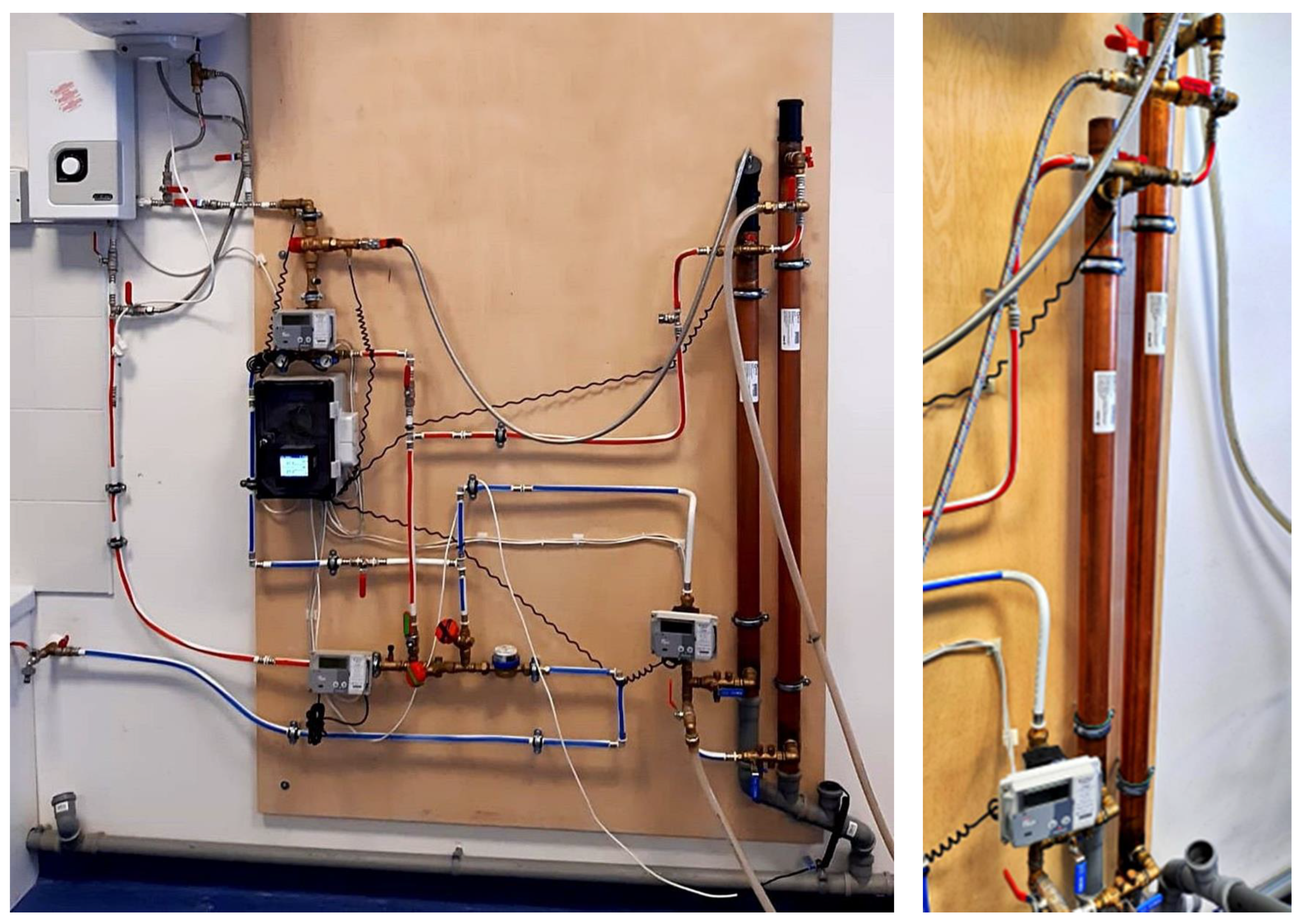
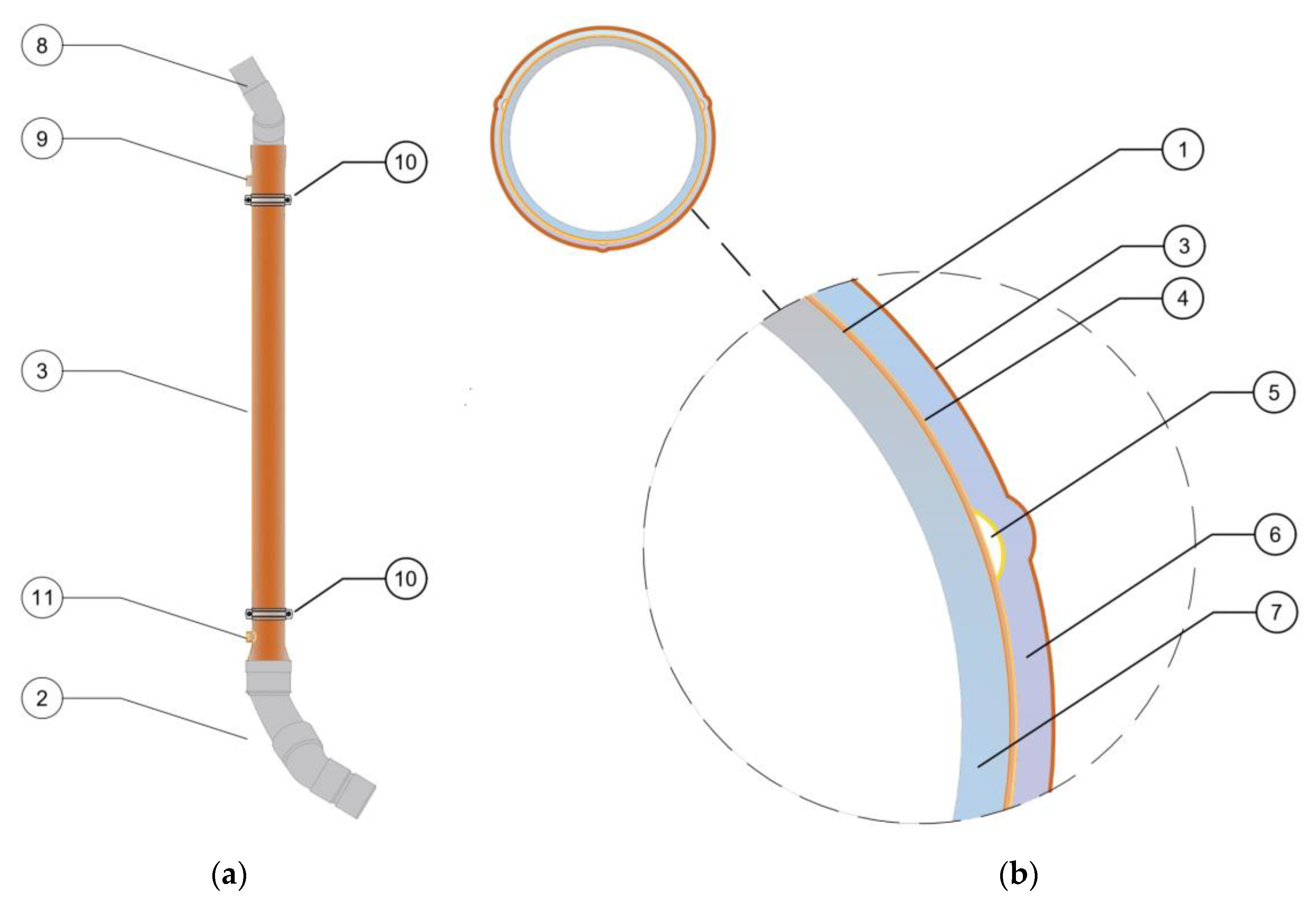
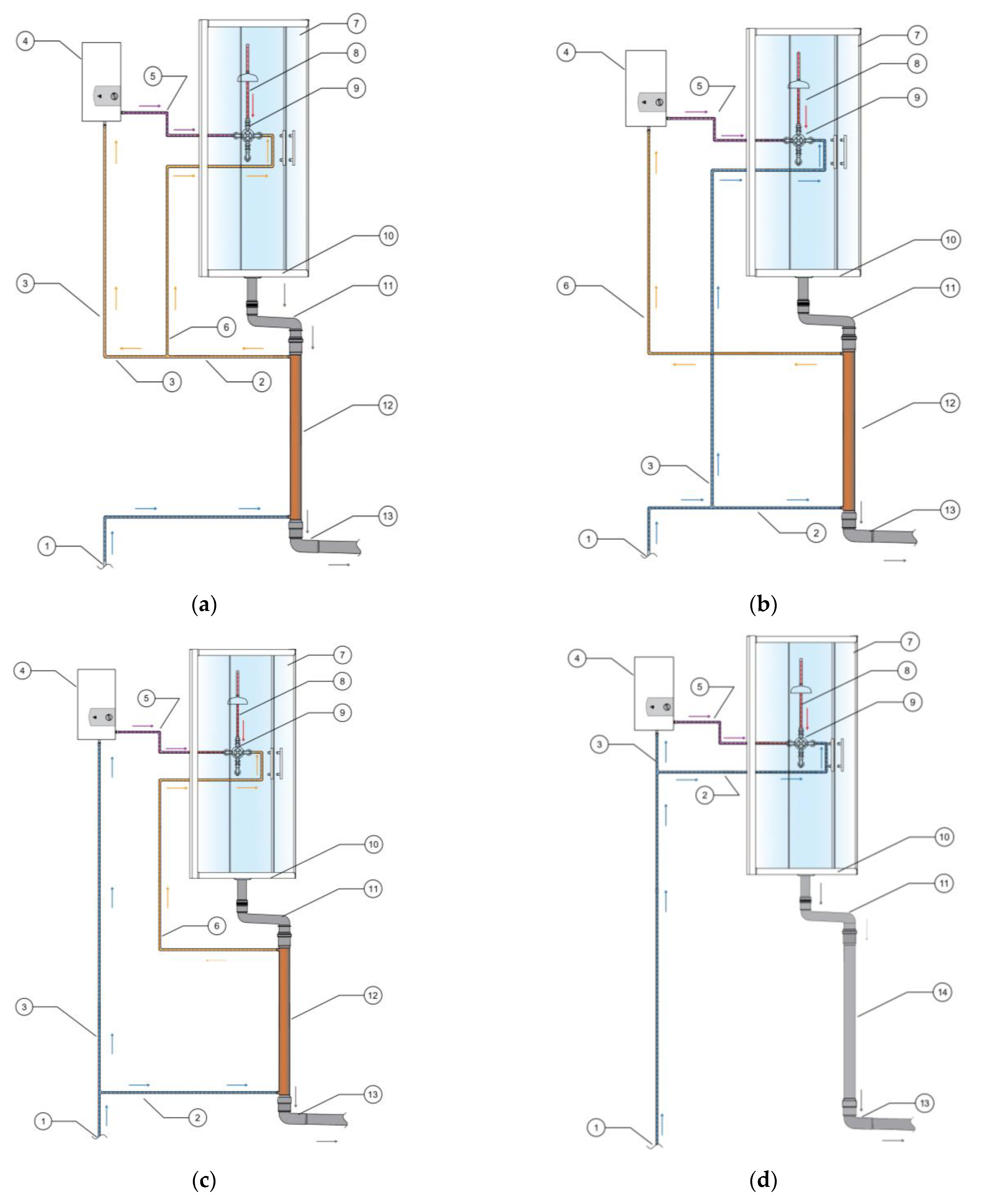
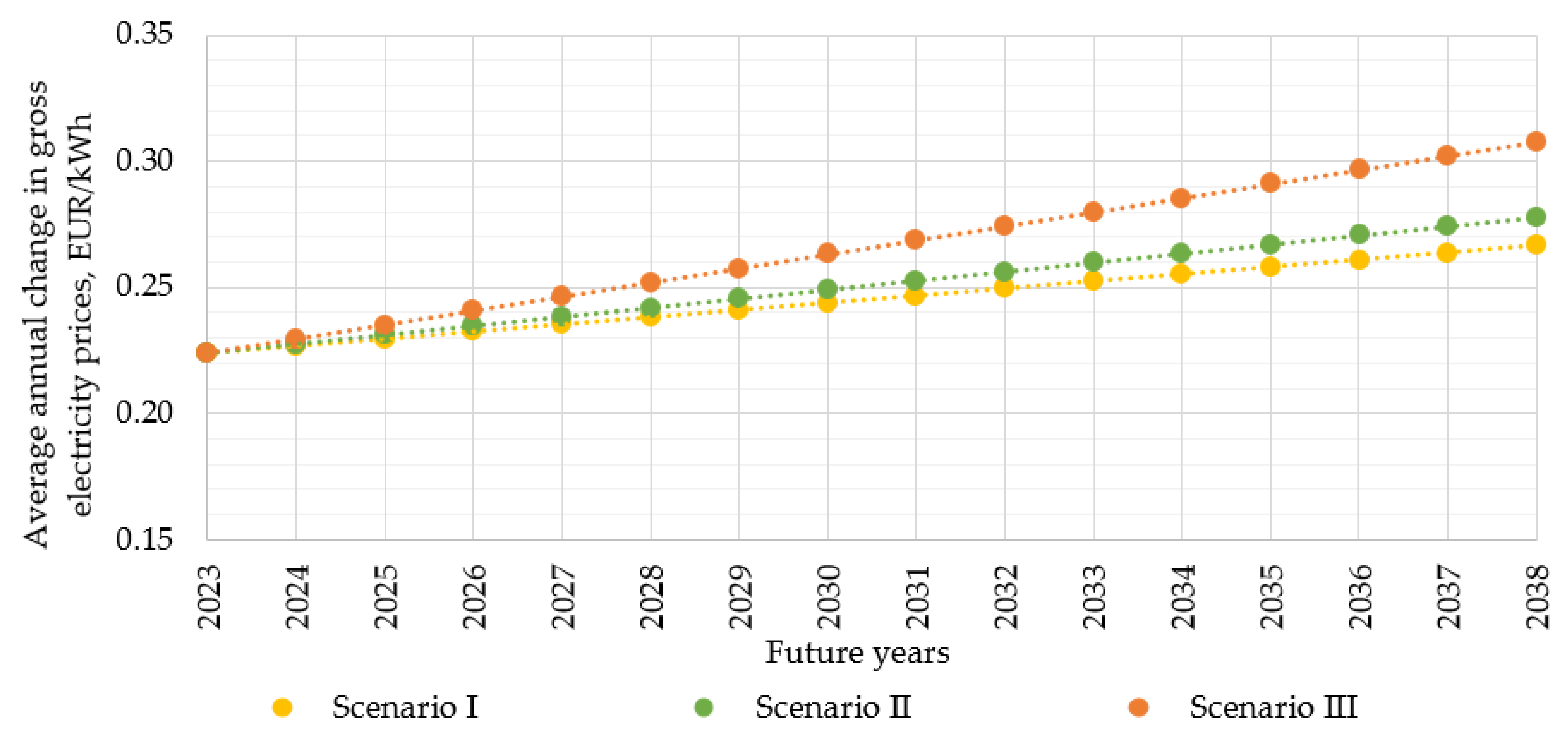

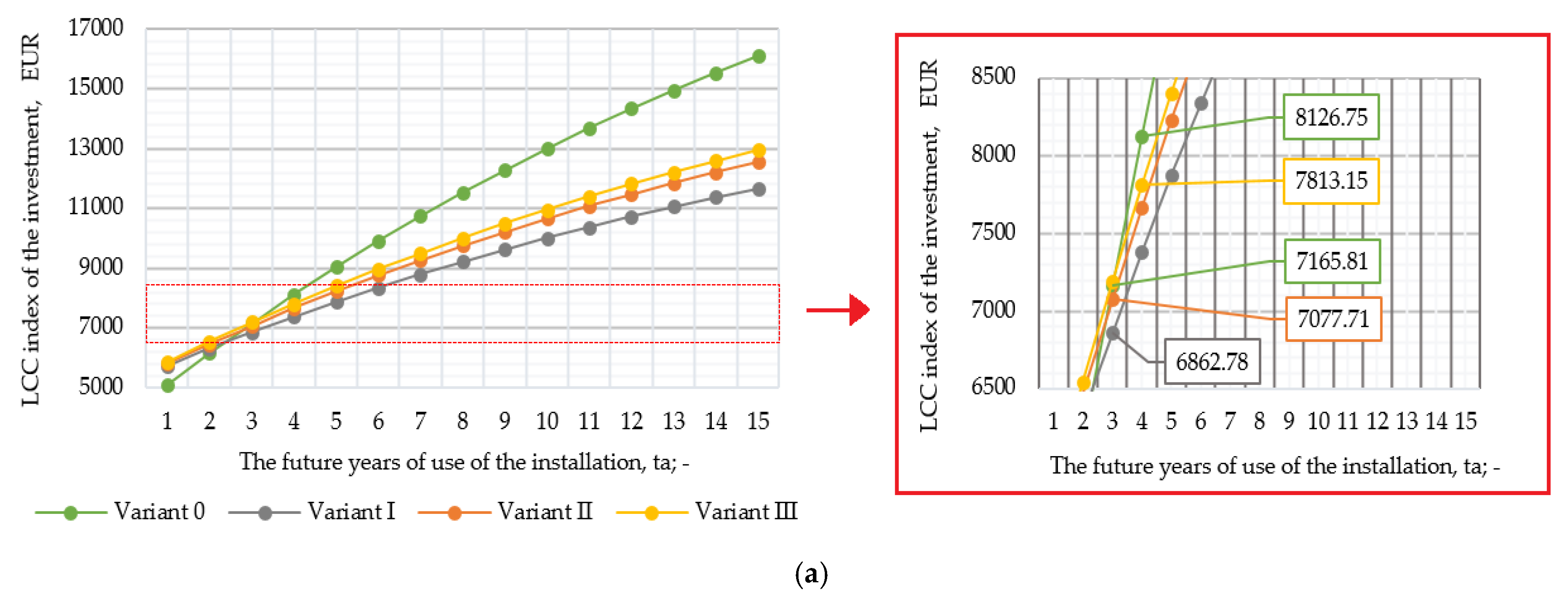

| Parameter | Unit | Variant I | Variant II | Variant III | Variant IV |
|---|---|---|---|---|---|
| Capital expenditures in the base year | EUR | 5149 | 5125 | 5140 | 3985 |
| Price of water and wastewater in the base year | EUR/m3 | 2.22 | 2.22 | 2.22 | 2.22 |
| Electricity price in the base year | EUR/kWh | 0.22 | 0.22 | 0.22 | 0.22 |
| Number of system users | - | 4 | 4 | 4 | 4 |
| Lifetime | years | 15 | 15 | 15 | 15 |
| Discount rate | - | 0.05 | 0.05 | 0.05 | 0.05 |
| Single shower length | s | 480 | 480 | 480 | 480 |
| Temperature of the Water Mixed at the Shower Head Outlet, Tm | Volume Flow of Water Mixed at the Shower Head Outlet, Q | Variant I | Variant II | Variant III | |||||||||
|---|---|---|---|---|---|---|---|---|---|---|---|---|---|
| Cold Water, Tc | Preheated Water, Tph | Qph/Q | Energy Efficiency, ε | Cold Water, Tc | Preheated Water, Tph | Qph/Q | Energy Efficiency, ε | Cold Water, Tc | Preheated Water, Tph | Qph/Q | Energy Efficiency, ε | ||
| °C | dm3/min | °C | °C | - | % | °C | °C | - | % | °C | °C | - | % |
| 38 | 7.5 | 12.00 | 27.71 | 1.00 | 60.12 | 12.00 | 31.66 | 0.61 | 45.47 | 12.00 | 30.83 | 0.70 | 49.96 |
| 42 | 12.00 | 30.43 | 1.00 | 60.81 | 12.00 | 33.87 | 0.70 | 50.53 | 12.00 | 34.55 | 0.63 | 46.81 | |
| 38 | 10 | 12.00 | 27.43 | 1.00 | 58.74 | 12.00 | 31.46 | 0.61 | 44.90 | 12.00 | 30.62 | 0.69 | 48.93 |
| 42 | 12.00 | 29.92 | 1.00 | 59.28 | 12.00 | 33.53 | 0.70 | 49.68 | 12.00 | 34.31 | 0.62 | 45.74 | |
| The Life Cycle Cost Reduction Index of the Investment, EUR | ||||||||||||
|---|---|---|---|---|---|---|---|---|---|---|---|---|
| The future years, ta | Scenario 0 | Scenario I | Scenario II | Scenario III | ||||||||
| Variant I | Variant II | Variant III | Variant I | Variant II | Variant III | Variant I | Variant II | Variant III | Variant I | Variant II | Variant III | |
| Volume flow rate of the mixed water Q = 7.5 dm3/min | ||||||||||||
| 1 | −772 | −816 | −852 | −683 | −742 | −783 | −666 | −727 | −769 | −612 | −683 | −728 |
| 2 | −399 | −507 | −563 | −226 | −363 | −428 | −191 | −334 | −401 | −87 | −248 | −321 |
| 3 | −44 | −212 | −288 | 210 | −2 | −91 | 261 | 40 | −51 | 414 | 167 | 67 |
| 4 | 294 | 68 | −26 | 625 | 342 | 231 | 692 | 397 | 282 | 891 | 562 | 436 |
| 5 | 616 | 335 | 224 | 1021 | 670 | 537 | 1102 | 737 | 600 | 1344 | 938 | 788 |
| 6 | 923 | 589 | 461 | 1397 | 982 | 829 | 1492 | 1060 | 902 | 1777 | 1296 | 1123 |
| 7 | 1215 | 831 | 688 | 1756 | 1279 | 1107 | 1864 | 1368 | 1190 | 2189 | 1637 | 1442 |
| 8 | 1494 | 1061 | 903 | 2098 | 1562 | 1371 | 2218 | 1662 | 1465 | 2581 | 1962 | 1745 |
| 9 | 1759 | 1281 | 1109 | 2423 | 1831 | 1623 | 2556 | 1941 | 1726 | 2954 | 2271 | 2035 |
| 10 | 2011 | 1490 | 1304 | 2733 | 2088 | 1863 | 2877 | 2207 | 1975 | 3310 | 2566 | 2310 |
| 11 | 2251 | 1689 | 1490 | 3028 | 2332 | 2091 | 3183 | 2461 | 2212 | 3649 | 2846 | 2572 |
| 12 | 2480 | 1879 | 1668 | 3309 | 2565 | 2309 | 3474 | 2702 | 2437 | 3971 | 3114 | 2822 |
| 13 | 2699 | 2059 | 1836 | 3576 | 2786 | 2516 | 3752 | 2932 | 2652 | 4279 | 3368 | 3060 |
| 14 | 2906 | 2231 | 1997 | 3831 | 2998 | 2714 | 4016 | 3151 | 2857 | 4571 | 3611 | 3287 |
| 15 | 3104 | 2395 | 2151 | 4074 | 3199 | 2902 | 4268 | 3359 | 3052 | 4850 | 3841 | 3503 |
| Volume flow rate of the mixed water Q = 10 dm3/min | ||||||||||||
| 1 | −651 | −711 | −761 | −534 | −613 | −671 | −511 | −593 | −653 | −441 | −535 | −599 |
| 2 | −162 | −301 | −385 | 65 | −111 | −210 | 111 | −73 | −175 | 247 | 42 | −70 |
| 3 | 303 | 88 | −27 | 636 | 367 | 229 | 703 | 423 | 280 | 903 | 591 | 434 |
| 4 | 746 | 459 | 314 | 1180 | 823 | 647 | 1267 | 895 | 714 | 1528 | 1113 | 914 |
| 5 | 1168 | 812 | 638 | 1698 | 1256 | 1046 | 1804 | 1345 | 1127 | 2122 | 1611 | 1372 |
| 6 | 1570 | 1149 | 947 | 2192 | 1669 | 1425 | 2316 | 1773 | 1520 | 2689 | 2085 | 1807 |
| 7 | 1953 | 1469 | 1242 | 2662 | 2063 | 1786 | 2803 | 2181 | 1895 | 3228 | 2537 | 2222 |
| 8 | 2318 | 1775 | 1522 | 3109 | 2437 | 2130 | 3267 | 2570 | 2252 | 3742 | 2967 | 2617 |
| 9 | 2665 | 2065 | 1789 | 3535 | 2794 | 2458 | 3709 | 2940 | 2592 | 4231 | 3377 | 2993 |
| 10 | 2996 | 2342 | 2043 | 3941 | 3134 | 2770 | 4130 | 3292 | 2915 | 4697 | 3767 | 3351 |
| 11 | 3311 | 2606 | 2285 | 4328 | 3457 | 3067 | 4531 | 3628 | 3223 | 5141 | 4138 | 3693 |
| 12 | 3611 | 2857 | 2516 | 4696 | 3765 | 3350 | 4913 | 3947 | 3517 | 5564 | 4492 | 4018 |
| 13 | 3896 | 3096 | 2735 | 5046 | 4059 | 3620 | 5277 | 4252 | 3797 | 5967 | 4829 | 4327 |
| 14 | 4168 | 3324 | 2945 | 5380 | 4339 | 3876 | 5623 | 4541 | 4063 | 6350 | 5150 | 4622 |
| 15 | 4428 | 3541 | 3144 | 5698 | 4605 | 4121 | 5953 | 4818 | 4316 | 6715 | 5456 | 4902 |
| The Life Cycle Cost Reduction Index of the Investment, EUR | ||||||||||||
|---|---|---|---|---|---|---|---|---|---|---|---|---|
| The future years, ta | Scenario 0 | Scenario I | Scenario II | Scenario III | ||||||||
| Variant I | Variant II | Variant III | Variant I | Variant II | Variant III | Variant I | Variant II | Variant III | Variant I | Variant II | Variant III | |
| Volume Flow Rate of the Mixed Water Q = 7.5 dm3/min | ||||||||||||
| 1 | −826 | −886 | −876 | −749 | −828 | −813 | −733 | −817 | −800 | −687 | −782 | −762 |
| 2 | −503 | −644 | −610 | −353 | −532 | −487 | −323 | −509 | −462 | −233 | −441 | −388 |
| 3 | −197 | −414 | −357 | 23 | −249 | −176 | 67 | −216 | −140 | 199 | −117 | −31 |
| 4 | 96 | −195 | −116 | 382 | 20 | 120 | 439 | 63 | 167 | 611 | 192 | 308 |
| 5 | 374 | 14 | 113 | 724 | 277 | 401 | 793 | 329 | 459 | 1003 | 487 | 632 |
| 6 | 639 | 213 | 332 | 1049 | 521 | 669 | 1131 | 582 | 737 | 1377 | 767 | 940 |
| 7 | 892 | 403 | 540 | 1359 | 753 | 925 | 1452 | 824 | 1002 | 1732 | 1034 | 1233 |
| 8 | 1132 | 583 | 738 | 1654 | 975 | 1168 | 1758 | 1053 | 1254 | 2071 | 1288 | 1512 |
| 9 | 1361 | 755 | 927 | 1935 | 1186 | 1400 | 2050 | 1272 | 1494 | 2394 | 1530 | 1778 |
| 10 | 1579 | 919 | 1107 | 2202 | 1387 | 1620 | 2327 | 1480 | 1723 | 2701 | 1761 | 2032 |
| 11 | 1787 | 1075 | 1278 | 2457 | 1578 | 1831 | 2592 | 1679 | 1941 | 2994 | 1981 | 2273 |
| 12 | 1985 | 1223 | 1441 | 2700 | 1760 | 2031 | 2843 | 1868 | 2149 | 3273 | 2190 | 2503 |
| 13 | 2173 | 1365 | 1596 | 2931 | 1934 | 2221 | 3083 | 2048 | 2346 | 3538 | 2389 | 2722 |
| 14 | 2352 | 1499 | 1744 | 3152 | 2099 | 2403 | 3311 | 2219 | 2535 | 3791 | 2579 | 2930 |
| 15 | 2523 | 1628 | 1885 | 3361 | 2256 | 2576 | 3529 | 2382 | 2714 | 4032 | 2760 | 3129 |
| Volume flow rate of the mixed water Q = 10 dm3/min | ||||||||||||
| 1 | −724 | −805 | −789 | −624 | −729 | −706 | −604 | −714 | −690 | −544 | −668 | −640 |
| 2 | −306 | −486 | −441 | −110 | −337 | −279 | −71 | −307 | −246 | 46 | −218 | −149 |
| 3 | 93 | −182 | −109 | 379 | 36 | 128 | 436 | 79 | 176 | 608 | 210 | 318 |
| 4 | 473 | 107 | 207 | 845 | 391 | 516 | 920 | 448 | 578 | 1143 | 618 | 764 |
| 5 | 835 | 383 | 507 | 1289 | 729 | 885 | 1380 | 798 | 961 | 1653 | 1006 | 1187 |
| 6 | 1179 | 646 | 794 | 1712 | 1051 | 1237 | 1819 | 1133 | 1325 | 2138 | 1376 | 1591 |
| 7 | 1508 | 896 | 1067 | 2115 | 1358 | 1572 | 2236 | 1451 | 1673 | 2600 | 1728 | 1976 |
| 8 | 1820 | 1134 | 1327 | 2498 | 1650 | 1891 | 2634 | 1754 | 2004 | 3041 | 2064 | 2342 |
| 9 | 2118 | 1360 | 1574 | 2863 | 1929 | 2195 | 3013 | 2042 | 2319 | 3460 | 2383 | 2691 |
| 10 | 2401 | 1576 | 1810 | 3211 | 2194 | 2484 | 3373 | 2317 | 2619 | 3860 | 2688 | 3023 |
| 11 | 2671 | 1782 | 2034 | 3543 | 2446 | 2759 | 3717 | 2579 | 2904 | 4240 | 2977 | 3339 |
| 12 | 2928 | 1978 | 2248 | 3858 | 2687 | 3022 | 4044 | 2828 | 3176 | 4602 | 3254 | 3641 |
| 13 | 3173 | 2165 | 2452 | 4159 | 2916 | 3272 | 4356 | 3066 | 3436 | 4947 | 3516 | 3927 |
| 14 | 3406 | 2342 | 2646 | 4445 | 3134 | 3510 | 4653 | 3292 | 3682 | 5276 | 3767 | 4201 |
| 15 | 3628 | 2511 | 2831 | 4717 | 3341 | 3736 | 4935 | 3507 | 3918 | 5589 | 4005 | 4461 |
Disclaimer/Publisher’s Note: The statements, opinions and data contained in all publications are solely those of the individual author(s) and contributor(s) and not of MDPI and/or the editor(s). MDPI and/or the editor(s) disclaim responsibility for any injury to people or property resulting from any ideas, methods, instructions or products referred to in the content. |
© 2023 by the authors. Licensee MDPI, Basel, Switzerland. This article is an open access article distributed under the terms and conditions of the Creative Commons Attribution (CC BY) license (https://creativecommons.org/licenses/by/4.0/).
Share and Cite
Piotrowska, B.; Słyś, D. Analysis of the Life Cycle Cost of a Heat Recovery System from Greywater Using a Vertical “Tube-in-Tube” Heat Exchanger: Case Study of Poland. Resources 2023, 12, 100. https://doi.org/10.3390/resources12090100
Piotrowska B, Słyś D. Analysis of the Life Cycle Cost of a Heat Recovery System from Greywater Using a Vertical “Tube-in-Tube” Heat Exchanger: Case Study of Poland. Resources. 2023; 12(9):100. https://doi.org/10.3390/resources12090100
Chicago/Turabian StylePiotrowska, Beata, and Daniel Słyś. 2023. "Analysis of the Life Cycle Cost of a Heat Recovery System from Greywater Using a Vertical “Tube-in-Tube” Heat Exchanger: Case Study of Poland" Resources 12, no. 9: 100. https://doi.org/10.3390/resources12090100
APA StylePiotrowska, B., & Słyś, D. (2023). Analysis of the Life Cycle Cost of a Heat Recovery System from Greywater Using a Vertical “Tube-in-Tube” Heat Exchanger: Case Study of Poland. Resources, 12(9), 100. https://doi.org/10.3390/resources12090100








